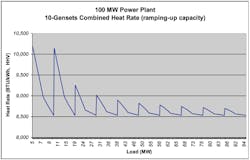Wind energy has become a major factor in the United States’ power generation equation. According to the American Wind Energy Association, 6,810 MW of new wind capacity was installed across the US during 2011. This brings the nation’s total installed capacity to 46,919 MW. With an additional 100 projects spanning 31 states currently under development, this value is projected to increase by an additional 8,300 MW upon completion. Today, 39 states have utility-scale wind installations, and the total US wind power capacity represents more than 20% of the world’s installed wind power. Pike Research expects installations in the US to reach 125 GW by 2017, more than doubling the existing and soon to be installed capacity of this renewable energy resource.
This growth does present challenges, particularly due to the intermittent nature of wind resources. Understandably, wind does not always blow when electricity is needed. And, unfortunately, wind cannot be stored, nor can the energy generated by wind farms (at least not in a cost-effective manner). Further, good wind sites are often constructed in remote locations far from areas of significant electric power demand such as heavily populated metropolitan areas and industrial parks. This can cause grid instability and high losses by the time wind energy ultimately reaches the load centers where it is needed.
Wind power continues to grow as a preferred source of sustainable energy. Utilities, dispatch centers, and independent system operators are struggling to find cost-effective ways to manage the fluctuations in available energy that is inherent with wind power. To address this concern, they must compliment their wind resources with other dispatchable resources that offer more flexibility and control to effectively manage sudden changes in supply and demand of power.
To address this variability, the aforementioned stakeholders that rely on wind farms are turning to medium speed reciprocating engine generator sets to provide flexible backup power. This low-emissions, natural gas-fired power generation technology is one of the most reliable and efficient solutions available to support unpredictable wind capacity.
Minute-to-minute fluctuations in wind capacity force utilities to quickly adapt to electricity demand. Energy supplied by traditional, coal-fired plants or turbines can take hours to reach full load, and while they represent a good alternative for base load applications, they are not effective in meeting sudden spikes in demand. Natural gas reciprocating engines, on the other hand, can respond to these demands at much faster speeds. Power plant solutions supplied by Caterpillar Power Generation Systems can be started and reach full load within seven minutes or less. Once synchronized, the plant can adjust to changing load demands in a matter of seconds.
When compared to turbines, medium speed generator sets offer a number of significant benefits to owners and operators of power plants seeking flexible generation. These include:
- Higher efficiency (42+%, net of parasitic loads)
- Lower derating at increasing temperatures and elevations
- Lower derating under partial load operation
- Lower water consumption due to closed loop cooling
- Shorter time to start, synchronize and reach full load
- Unlimited starts and stops at no additional costs
- Lower gas pressure needed to operate (6 bar), eliminating the need for additional and costly compression
The most effective power plants are those equipped with automatic generation controls (AGCs). AGCs enable the remote monitoring and adjustment of power output from each of the plant’s generators based on rapid fluctuations in the system frequency, ensuring that the load and the generation needs are balanced. Through remote monitoring and the use of AGCs, these power plants can be used to inject or absorb reactive power from the grid to maintain transmission system voltages within required ranges.
The ability to change the number of engines operating based on the load required at a specific time is a significant benefit of designing a power plant with medium speed natural gas reciprocating engines. For example, a 10-engine, 100-MW power plant will run each engine at 100% load when full demand is required of the plant. However if, during non-peak hours, only 50 MW is required, it would be more efficient to run five engines at 100% load than running all 10 engines at 50% load. Individual gensets running at partial loads have higher heat rates than when run at full load. Because lower heat rates equate to lower fuel consumption, maximizing the number of engines running at full load while minimizing the number running at partial loads will reduce fuel consumption. This operation model also increases plant reliability and availability because multiple engine redundancy enables the execution of scheduled and unscheduled maintenance, allowing the plant to remain sufficiently operable during repairs (see chart below).
Another advantage offered by gas reciprocating engines is their closed-loop cooling system. Closed-loop cooling systems require virtually no make-up water and eliminate the need for wastewater treatment or disposal. In many states, access to an unlimited supply of water can be both problematic and costly.
Spinning and Non-spinning Reserve
Ancillary services offer additional resources to meet reliability requirements. They support basic electrical services such as generating capacity, energy supply and power delivery. With ancillary services, utility operators can rest assured that their transmission systems are operating properly and supplying the power their customers require. Spinning and non-spinning reserves are two types of ancillary services.
Natural gas engine power plants can assist in the provision of both spinning and non-spinning reserves. Spinning reserve as defined, means that reserve generator sets can be kept spinning, without producing energy, as a way to reduce the length of time required to bring them online when needed. The spinning reserve is the extra generating capacity that is available by increasing the power output of generators that are already connected to the power system. This capacity is ready to instantaneously respond to control signals from the system operator in order to maintain transmission system integrity.
Non-spinning reserve is generating capacity that can be brought online within 10 minutes of dispatch and can be maintained at that output for at least two hours. Non-spinning reserve is necessary to maintain system frequency stability during emergency conditions.
In either case, natural gas power plants using medium speed engines can run for a few minutes or many hours, with loads ranging from 50 to 100% per generator set, whatever is needed to restore spinning and non-spinning reserves to their pre-contingency status. They do this while maintaining better fuel efficiency throughout the load curve as compared to other power generation technologies such as turbines.
As wind energy capacity increases, utilities will face a growing challenge to meet the peaks and valleys associated with fluctuating wind power while keeping energy prices stable for their valued customers. Supplementing power generation capacity with a Cat natural gas-fired, medium speed reciprocating engine power plant is a cost-effective, environmentally friendly means to enhance the overall success of a utility.




